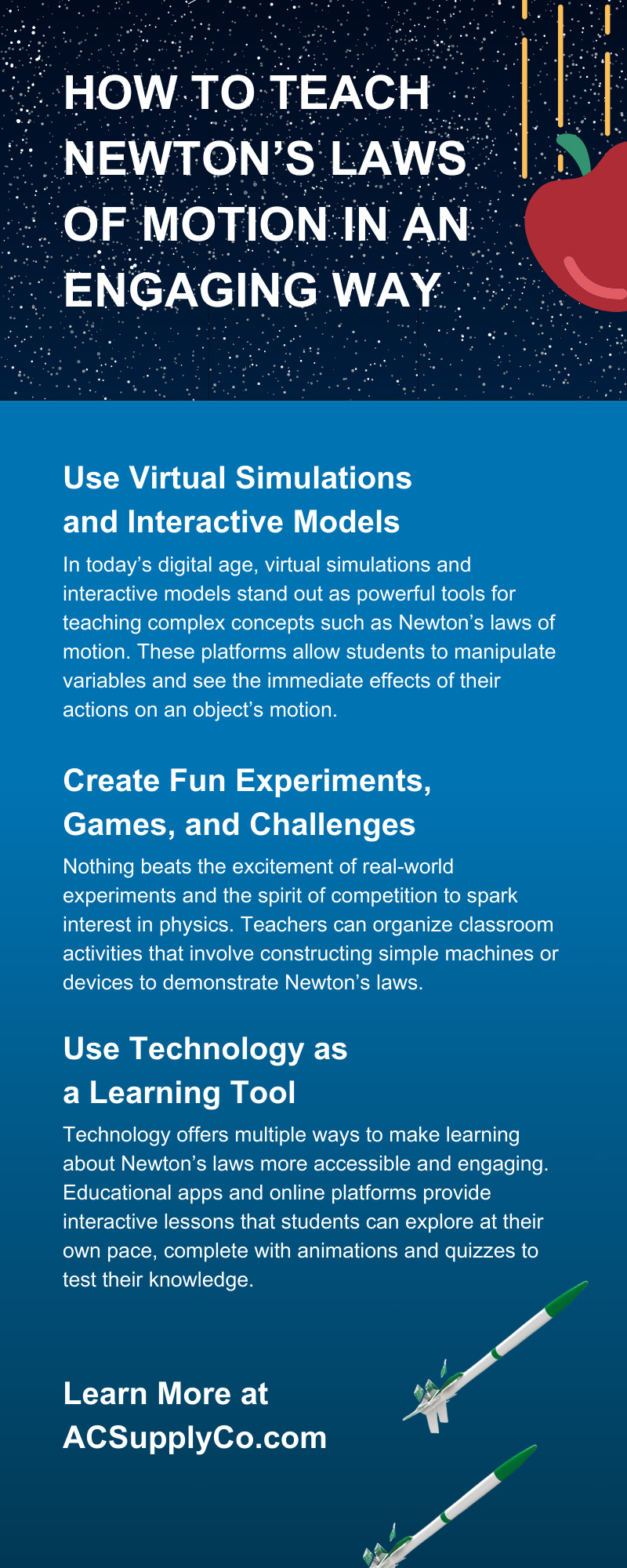Teaching Newton’s laws of motion presents a unique opportunity to blend the marvels of physics with practical, everyday experiences. Sir Isaac Newton’s contributions to the understanding of our physical world remain foundational, even centuries after their discovery.
By bringing these laws to life through interactive, engaging methods, educators can inspire students to appreciate the intricacies of physics. Let’s explore how to teach Newton’s laws of motion in an engaging way. The goal is to make the learning process educational and immensely enjoyable for students.
Use Virtual Simulations and Interactive Models
In today’s digital age, virtual simulations and interactive models stand out as powerful tools for teaching complex concepts such as Newton’s laws of motion. These platforms allow students to manipulate variables and see the immediate effects of their actions on an object’s motion.
By adjusting mass, force, and friction, learners can visualize how these changes influence acceleration, offering a hands-on understanding of the laws in a controlled, virtual environment. This direct interaction enhances comprehension and retention, making abstract principles concrete.
Create Fun Experiments, Games, and Challenges
Nothing beats the excitement of real-world experiments and the spirit of competition to spark interest in physics. Teachers can organize classroom activities that involve constructing simple machines or devices to demonstrate Newton’s laws.
For example, creating balloon-powered cars can illustrate the third law: for every action, there is an equal and opposite reaction. Incorporating games and challenges where students predict outcomes based on their understanding of these laws further encourages active participation and critical thinking.
Use Technology as a Learning Tool
Technology offers multiple ways to make learning about Newton’s laws more accessible and engaging. Educational apps and online platforms provide interactive lessons that students can explore at their own pace, complete with animations and quizzes to test their knowledge.
Augmented reality (AR) apps bring an innovative dimension to physics education, overlaying digital information over the real world and allowing students to see the laws in action through their devices. This integration of technology supports diverse learning styles and makes complex concepts more digestible.
Link Newton’s Laws to Career Opportunities
One of the most compelling ways to engage older students is by showing them how Newton’s laws pave the way for various career paths. From engineering and aerospace to game design and sports science, the principles of motion and force play a crucial role in many industries.
Highlighting the application of these laws in designing roller coasters, cars, or rockets can illuminate the tangible career opportunities awaiting those who excel in physics. Such connections will enrich the learning experience and inspire students to envision their future contributions to science and technology.
Show How Newton’s Laws Affect Our Daily Lives
Demonstrating the relevance of Newton’s laws in everyday activities can transform students’ perception of physics from a purely academic subject to a fascinating aspect of their daily lives. Whether it’s understanding why seat belts are essential or how athletes use momentum to their advantage, real-life applications make these laws relatable.
Teachers can also encourage students to identify examples of Newton’s laws in action. From skateboarding tricks to the way a model rocket propels into the sky, linking classroom learning to the world around them is a great way to make a lesson plan more engaging.
Use Model Building as a Break From Traditional Learning
Model building serves as a refreshing detour from textbook learning, allowing students to physically engage with the concepts of force, mass, and acceleration.
Constructing models, such as simple machines or bridges, enables learners to see Newton’s Laws in action. This hands-on approach reinforces theoretical knowledge and enhances problem-solving and critical thinking skills.
Show Them the People Behind These Laws
Introducing students to the figures behind the laws, including Sir Isaac Newton himself, humanizes the subject matter. Sharing stories about their lives, discoveries, and the historical context of their work makes the laws more relatable.
Understanding the struggles and achievements of these pioneers adds a layer of depth to the learning experience, reminding students that groundbreaking discoveries often come from questioning the status quo.
Show Students Short-Form Videos About Newton’s Laws of Motion
Leveraging popular social media platforms such as TikTok, where educators and enthusiasts share science content, can make learning more relatable and engaging.
Short-form videos can demonstrate Newton’s Laws in everyday situations, making these abstract concepts more tangible. Watching these videos can help students better understand the material and introduce them to the fun side of physics.
Have Students Create Their Own Videos
Encouraging students to create their own videos for a school project will allow them to explore Newton’s laws in a creative way.
A visual project will reinforce their understanding of the lessons and improve their ability to communicate complex ideas in an accessible manner.
Additionally, it fosters a sense of achievement and can create interest in STEM fields among peers.
How Students Can Learn Newton’s Laws Through Sports
Sports provide a compelling context to explore and understand Newton’s Laws. By analyzing the forces involved in throwing a ball, running, or jumping, students can relate the laws to activities they are familiar with.
This approach can make learning more fun and help students incorporate their learning into their sporting endeavors.
Why Are Newton’s Laws Difficult for Students To Understand?
Newton’s Laws of Motion delve into abstract concepts that require students to visualize forces and motions that aren’t always apparent in everyday life.
The leap from observing physical phenomena to understanding the invisible forces at play can be challenging.
Furthermore, the mathematical aspect of these laws can be daunting for those who struggle with equations and calculations.
How AC Supply Can Help Educators Teach Newton’s Laws of Motion
Teaching Newton’s laws of motion in an engaging way requires creativity, technology, and a connection to the real world. By employing the tips above, educators can ignite a passion for learning that extends beyond the classroom.
One day, the students teachers inspire will use their knowledge of Newton’s laws to innovate in fields like aerospace. Or maybe they will strike up a lifelong passion for building hobby rocket engines from AC Supply.
With the help of our educational materials, teachers can help students see the beauty and relevance of physics in everything they do. Review our website to see the types of science projects you can use in your classroom.



